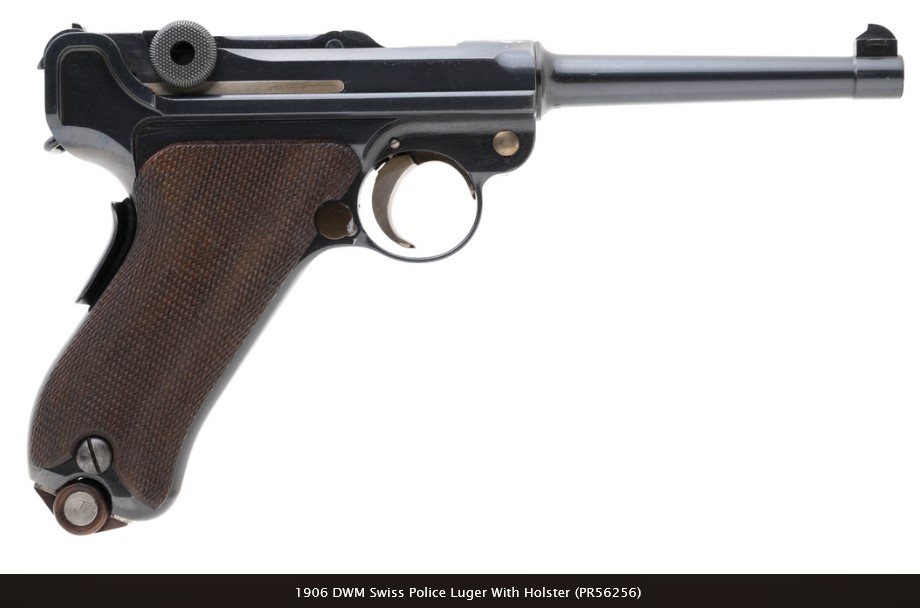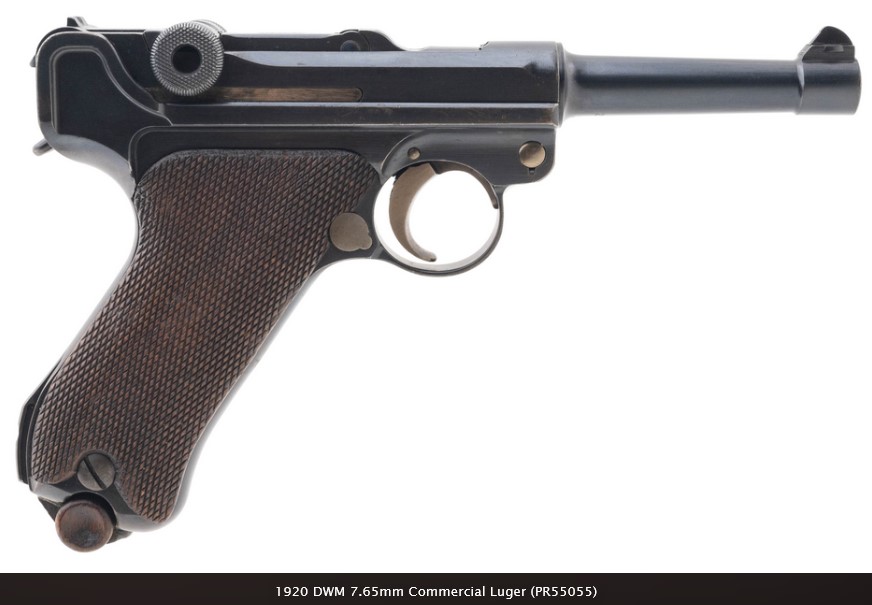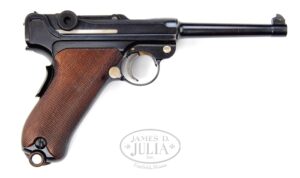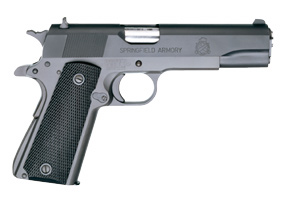Browsing through the “new arrivals” at Collectors, I stumbled across not one but two older Lugers. If you haven’t watched Othias and Mae’s take on this splendid old piece — and shame on you if you haven’t — go there now and spend a worthwhile hour learning about the Pistole 08.
The first one that caught my eye is a “Swiss”-type Model 1900 Luger, issued to the Swiss police, and was the first Luger to be adopted by anyone.

What interests me is that firstly, we know that this little beauty was well-looked after for at least the first 50 years of its life because it was used by a 1.) Swiss 2.) policeman, and I bet that since its arrival in the U.S. some fifty-odd years ago, it’s been just as carefully maintained. As its price (just under $3,000) would indicate, this is like to be a cherry, and scarce withal because the Swiss ordered only a few thousand of them. Only later did those 1900 Police models (chambered in 7.65x21mm Parabellum / .30 Luger) get replaced by the P.08 in 9mm Parabellum, which means that this particular model spent most of its life in Switzerland locked in a cabinet somewhere as surplus (the Swiss never sold off their older-model Lugers to civilians until they opened them up for export in 1959).
The second of the Lugers is a “commercial” (i.e. private) piece:

Note that the Swiss model can be distinguished from the commercial one by the added grip safety (which was part of the Swiss list of requirements). As with all such guns, we can’t be sure of this one’s condition because we don’t know how owners have handled the thing (and its price, under $2,000, reflects both that and its non-rarity, as they were produced in the tens of thousands). Unlike most of the Lugers out there today, this particular one is also chambered in 7.65mm Parabellum.
…which of course is going to raise the question: “Hey Kim, if you think the 115gr 9mmP is a useless Europellet, why do you like the smaller 93g .30 Luger cartridge so much?” and it’s a valid question.
Simple answer: it’s more fun to shoot, and makes no claim to being an effective self-defense cartridge. It used to be thought of that way, back in the very early 1900s when the cartridge was first released, but the Euros hadn’t yet been exposed to the .357 Magnum or even the .45 ACP. (For some reason, Euros have always preferred inadequate cartridges in their handguns. No, I don’t know why either.)
More importantly, I actually used to own a Luger chambered in 7.65mm, sold it under extreme duress, and I can truthfully say that of the many hundreds of centerfire pistols I’ve fired in my lifetime, that Luger ranks #3 in the “fun gun” category. (#1 is the 1905 Colt in .32 ACP, and #2 is the SIG Sauer P230, also in .32 ACP.) I still wish I’d kept it.
Fun guns are those that you do not shoot for practice, e.g. self-defense or competition, but on those occasions when you just shoot at cans or something, and you don’t want to shoot .22 LR (it can happen), or you just feel like shooting a different gun.
And boy, is that Luger ever different.
Ammo cost is surprisingly low. Prvi Partizan (bless their little Balkan hearts) make the .30 Luger, and the retail thereof is about 60 cents/round. Sellier&Bellot 9mmP compares at 35 cents, but then again you’re going to shoot your Europellets in the thousands versus the .30 Lugers by the dozen.
Another point of query might be shooting a pistol with the severe grip angle/rake of the Luger (and Ruger .22 pistols) compared to my favorite style of the 1911:


The Luger grip doesn’t require familiarity — it is, after all, more of a curio than a “functional” gun.
All that said, if I had the dough right now I’d be talking about that Swiss beauty as a recent acquisition rather than as an object of desire.

Othias & Mae are national treasures. As someone who loves history up to WW1, I am incredibly grateful they are tackling the different firearms from the era.
If I were a wealthy man, I’d sponsor their show so they at least got a little vig off of all the hard work they do.
That said, there’s been uncounted man hours of mine, captured by them, and my project pile has not shrunk.
The 1900 with it’s slimmer bbl has a certain grace to it.
I’ve been tempted by the P38 and the Lugers but their price tags put me off. Also, especially with Lugers there are lots of variations that make one collectible or valuable and in order to make an intelligent purchase would require me to buy rather expensive books to do proper research. To satisfy the grip angle, I’ll just stick with a Ruger Mk II.
beautiful handguns. Never fired anything in the smaller calibers such as .25, 30 Luger, .32 and such. .22 .380 and 9mm on up are the semi auto pistol cartridges that I have experience
JQ
As for lethality, that 7.65 would poke a hole in you and in the early 1900s that was often fatal. Hospitals weren’t as commonplace and penicillin wasn’t widespread until the 30s. It wouldn’t stop a bad guy in his tracks but he’d have several miserable days to realize he’d screwed up.
USMC
Thank you for educating me. They sure are tempting firearms.
I keep coming to a M&P Shield in 9mm, S&W 442 with .38+P specials or 1911 to carry.
I have had a Walther PPK/S in .380acp made by Interarms that was handy to carry but the bottom of the slide was rather sharp. Accurate little thing but snappy to shoot.
JQ
The problem with +P in the 442 is too much recoil, which really slows down the time to next shot. The typical very small grips are a problem for both control and practice amount. Weigh the difference in recoil and ballistic performance with the 1 7/8″ barrel. Slightly bigger grips that cover the backstrap can really help, and they don’t need to protrude below the bottom of the frame, but do need to fill in behind the trigger guard.
The sights seem to be regulated for 125 gr bullets. The heavy bullets puts you right back in the arena of +P control again.
For a 1911, I wouldn’t go shorter than the old Officers Model, with a 3.5″ barrel. The 4″ or 4 1/4″ would be better if you can conceal it. Bear in mind that the biggest problem with concealing a 1911 is the length of the grip, in most locations.
The main advantage of the 442 is that the shape of a snubbie is more organic than the angles of an auto, even a cut down one. Printing with a 442 is not really noticeable to people, generally speaking, and can be stuffed into a pocket (with holster) in some cases.
A friend of mine let me shoot his reasonably priced FrankenLuger (one without matching serial numbers) a while ago. It was a trip to shoot such an iconic weapon, but, damn it was hard to aim. The rear sight was the tiniest notch I’d ever seen on a handgun. I hit the target paper is all I’m gonna say.
When I handed the Luger back to him I sai “No wonder you see German officers in the movies delivering the coup de grace with the gun…You can’t hit anything at a distance because of the sights.”
Maybe it was me. It was before my cataract surgery…
Kim,
Thanks for the link to C&Rsenal. I got lost in that video, some of their other ones and then explored 1911 videos and the chore list got delayed. For penance I had to go to the market with the missus. Not a bad trade off
JQ